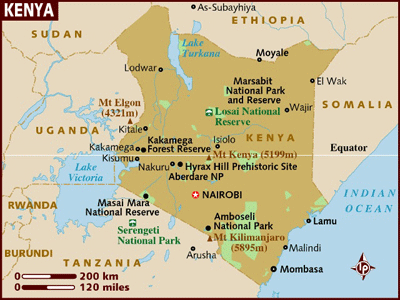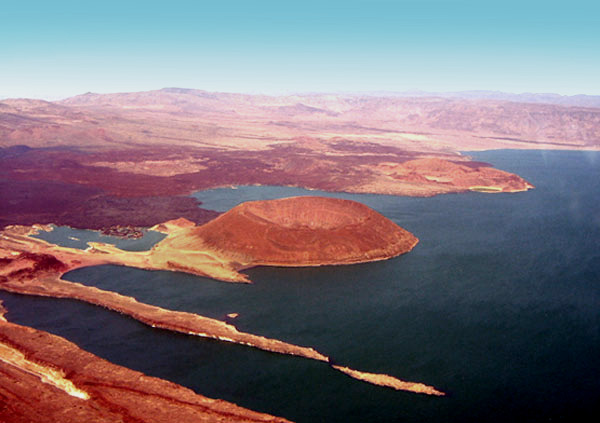The Republic of Kenya is a country in Eastern Africa. It is bordered by Ethiopia to the north, Somalia to the east, Tanzania to the south, Uganda to the west and Sudan to the northwest, with the Indian Ocean running along the southeast border.
Its capital is Nairobi, and Mombassa is one of the most important cities. It is comparable in size to France, with a population of 32 million inhabitants. It is member of the Commonwealth, because it was a British colony. As a result, English is one of the official languages, as well as Swahili.

Before explaining the main topic of my oral presentation, “Kenya as the cradle of humankind”, I’d like to remark one thing I found out when I was looking for information about Kenya. In Spanish, we refer to people from Kenya as “keniata”, and this is a misunderstanding: the people from Kenya are “kenianos”. The mistake comes from the name of the first president Kenya had as a free nation in 1963: Jomo Kenyatta. He was president until his death in 1978, for 15 years. Spanish media spoke about “el presidente Kenyatta” as well as they spoke about “el presidente Kennedy”, for example. But as he was president of Kenya, people started to understand that “Kenyatta” was the way to refer to people from Kenya. And now, we hear “los atletas keniatas”, for example, instead of “los atletas kenianos”, which is the correct expression.
After this little explanation, starts “Kenya: the cradle of humankind”.
In the north west of Kenya there is a lake, Lake Turkana, called by the British colonists Lake Rodolfo and also known as Jade Sea because of its fabulous jade colour that makes contrast with the surrounding desert. It is said to be one of the most beautiful places in Kenya.

Lake Turkana is 250 kilometres long and 50 kilometres across in its widest part. At midday, temperatures can reach 50ºC, but at night, suddenly, a violent storm can suddenly appear, with lots of rain. It can disappear as quickly as it came. It is said that 10 metres of the water evaporate each year, and it is one of the hottest places in Africa. 10,000 years ago the water level was higher than now, and Lake Turkana was one of the Nile sources, as the Nile crocodiles that live there nowadays prove.
Two million and a half years ago the lake was larger and the area more fertile, with a richer vegetal and animal life. An examination of sediments shows that the area was a floodplain—it was humid. So it wasn't always the dry, dusty place we see in movies. It was in this scenery where a kind of ape that lived in the forest dared to go into open land, into the savannah, where this ape evolved until it was a human being.
In 1871, Darwin said it was probable that the origins of humanity were African. The first theories about human evolution believed that our human ancestors were two different species: Australopithecus Africanus and Australopithecus Robustus. One of these species would have extinguished, while the other would have given birth to the Homo Sapiens.
But the spectacular discoveries made in Kenya had completely modified these theories about the origins of mankind. Louis and Mary Leakey, an English paleanthropologist married couple that lived in Kenya since the 1920’s, collected, in a few years, plenty of stone objects and many hominid and monkey’s fossils that covered a period of more than 25 million years. They suggested that there was a third species, contemporary to the Australopithecus—the Homo Habilis—, that gave birth to the actual Homo. The other two extinguished.
They passed their fossil-hunting tradition on to their son, Richard Leakey, who has led numerous anthropological digs in the shore of Lake Turkana.
In 1984, Leakey’s team made its most important discovery in the west shore of Lake Turkana. They unearthed the most complete skeleton of a prehistoric human ever found, the only major omissions being hands and feet, an Homo Erectus from 1,6 million years ago. They called it the Turkana Boy. It was believed to be 12 years old, but some scientists believe Erectus matured faster than modern humans (common chimpanzees mature more quickly than Homo Sapiens) and that he was really about 9 years old. The boy was 160 cm tall, and he might have been about 185 cm as an adult.
Turkana Boy's skeleton tells an interesting story. It is very similar to that of modern boys, although there are small differences. He was much like the Masai people that inhabit Kenya today, he had long slender limbs that helped him survive in the African heat. He had a bone structure that allowed him to walk and run very fast. The neck of his femur is longer than in modern man and he also had extra vertebrae and thicker femur bones, which provided more support and mobility than we experience today.
The pelvis of Turkana Boy is quite narrow, which suggests that infants were born with smaller brains than now. Modern Homo has wider pelvis and we lost the extra vertebrae to make room for babies with a larger capacity to learn and the ability to speak, something it's thought Turkana Boy may not have been able to do since the holes in his vertebrae, through which the spinal cord goes, have only about half the cross-sectional area found in modern humans. One suggested explanation for this is that the boy lacked the control we have in the thorax to control speech, implying that he wasn't as fluent a speaker as modern humans are. In short, for bigger brains we have to endure some limits in our bipedalism.
Turkana Boy had an infection from gum disease that led to his death at the young age of 9 or 10. His body came to rest in a place near Lake Turkana amongst greenery, and 1.6 million years later it was the growth of life that reintroduced him to the world: a tree began to grow from the fossilized cranium of the boy, slowly bringing fragments of bone to the surface. In 1984 those fragments were found near Lake Turkana, in Kenya.
It is because of all these important discoveries that Kenya is known under the nickname of “the cradle of humankind”.
